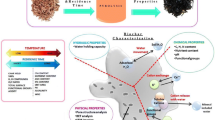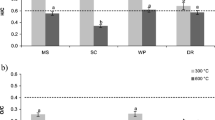Abstract
We investigated the potential application of pyrolysis treatment to a mixture of woody biomass and a metal-contaminated soil as an alternative eco-friendly option to stabilize metals in soils. Our specific objective was to test the optimum combination of high heating temperature (HHT) and heating time to effectively encapsulate metals in a contaminated soil into a biochar. For this purpose, we used a laboratory bench batch reactor to react a mixture of multi-element metal contaminated soil with 0% (control) 5%, 10%, and 15% (w/w) sawdust. Each mixture was reacted at 200°C and 400°C HHT for 1 and 2 h heating times. Physicochemical and morphological characterization along with standard EPA Synthetic Precipitation Leaching Procedure (SPLP) test were conducted to assess the effectiveness of the heat treatment to immobilize the metals in the contaminated soil. Compared to controls, we recorded up to 93% reduction in Cd and Zn leachability after 1 h heat treatment at 400°C, with the addition of 5–10% biomass. Pb leaching was reduced by 43% by the same treatment but without the addition of biomass. At lower pyrolysis temperature (200°C), however, there was a substantial increase in both As and Zn leaching compared to the untreated controls. Our study suggests that several factors such as the type of metal, heating temperature, heating period, and the addition of biomass influence the efficiency of pyrolysis to immobilize metals in the contaminated soil.



Similar content being viewed by others
References
Adriano, D. C. (2001). Trace elements in terrestrial environments: Biogeochemistry, bioavailability, and risks of metals (3rd ed.). New York: Springer-Verlag.
Arocena, J. M., & Opio, C. (2003). Prescribed fire-induced changes in properties of sub-boreal forest soils. Geoderma, 113, 1–16.
Arocena, J. M., Pawluk, S., Dudas, M. J., & Gajdostik, A. (1995). In situ investigation of soil organic matter globules using infrared microscopy. Canadian Journal of Soil Science, 75, 327–332.
Brady, N. C., & Weil, R. R. (2002). The nature and properties of soils (13th ed.). Upper Saddle River: Prentice Hall.
Brown, R. (2009). Biochar production technology. In J. Lehmann & S. Joseph (Eds.), Biochar for environmental management: Science and technology (pp. 127–146). London: EarthScan.
Brown, G. G., Barois, I., & Lavelle, P. (2000). Regulation of soil organic matter dynamics and microbial activity in the drilosphere and the role of interactions with other edaphic functional domains. European Journal of Soil Biology, 36, 177–198.
Cao, X., & Dermatas, D. (2008). Evaluating the applicability of regulatory leaching tests for assessing lead leachability in contaminated shooting range soil. Environmental Monitoring and Assessment, 139, 1–13.
Cao, X., Ma, L., Gao, B., & Harris, W. (2009). Dairy-manure derived biochar effectively sorbs lead and atrazine. Environmental Science & Technology, 43, 3285–3291.
Carter, M. R. (1993). Soil sampling and methods of analysis. Boca Raton: Lewis Publishers.
Cheng, C., Lehmann, J., Thies, J. E., Burton, S. D., & Engelhard, M. H. (2006). Oxidation of black carbon by biotic and abiotic processes. Organic Geochemistry, 37, 1477–1488.
Cheng, C., Lehmann, J., & Engelhard, M. H. (2008). Natural oxidation of black carbon in soils: changes in molecular form and surface charge along a climosequence. Geochemica et Cosmochemica Acta, 72, 1598–1610.
Chrysochoou, M., Dermatas, D., & Grubb, D. G. (2007). Phosphate application to firing range soils for Pb immobilization: the unclear role of phosphate. Journal of Hazardous Materials, 144, 1–14.
Debela, F., Arocena, J. M., Thring, R. W., & Whitcombe, T. (under review). Organic acids inhibit the formation of pyromorphite and Zn-phosphate in phosphorous amended Pb- and Zn-contaminated soil. Journal of Environmental Management.
Hashimoto, Y. M., Takaoka, M., Oshita, K., & Tanida, H. (2009). Incomplete transformations of Pb to pyromorphite by phosphate-induced immobilization investigated by X-ray absorption fine structure (XAFS) spectroscopy. Chemosphere, 76, 616–622.
Hettiarachchi, G. M., Pierzynski, G. M., & Ransom, M. D. (2001). In situ stabilization of soil lead using phosphorous. Journal of Environmental Quality, 30, 1214–1221.
Jakob, A., Stucki, S., & Struis, R. P. W. J. (1996). Complete heavy metal removal from fly ash by heat treatment: influence of chlorides on evaporation rates. Environmental Science & Technology, 30, 3275–3283.
Kistler, R. C., Widmer, F., & Brunner, P. H. (1987). Behavior of chromium, nickel, copper, zinc, cadmium, mercury, and lead during the pyrolysis of sewage sludge. Environmental Science & Technology, 21, 704–708.
Klute, A. (1986). Methods of soil analysis: Part 1—Physical and mineralogical methods (2nd ed.). Madison: American Society of Agronomy–Soil Science Society of America.
Lang, F., & Kaupenjohann, M. (2003). Effect of dissolved organic matter on the precipitation and mobility of the lead compound chloropyromorphite in solution. European Journal of Soil Science, 54, 139–148.
Lehmann, J., & Rondon, M. (2006). Bio-char management on highly weathered soils in the humid tropics. In N. Uphoff (Ed.), Biological approaches to sustainable soil systems (pp. 517–530). Boca Raton: Taylor and Francis.
Lehmann, J., Czimczik, C., Laird, D., & Sohi, S. (2009). Stability of biochar in the soil. In J. Lehmann & S. Joseph (Eds.), Biochar for environmental management: Science and technology (pp. 181–205). London: EarthScan.
Maiti, S., Dey, S., Purakayastha, S., & Ghosh, B. (2006). Physical and thermochemical characterization of rice husk char as a potential biomass energy source. Bioresource Technology, 97, 2065–2070.
Pulleman, M. M., Six, J., Uyl, A., Marinissen, J. C. Y., & Jongmans, A. G. (2005). Earthworms and management affect organic matter incorporation and microaggregate formation in agricultural soils. Applied Soil Ecology, 29, 1–15.
Rienks, J. (1998). Comparison of results for chemical and thermal treatment of contaminated dredged sediment. Water Science and Technology, 37, 355–362.
Santos, A., Santos, J. L., Aparicio, I., & Alonso, E. (2010). Fractionation and distribution of metals in Guadiamar River sediments (SW Spain). Water, Air, and Soil Pollution, 207, 103–113.
Scheckel, K. G., & Ryan, J. A. (2004). Spectroscopic speciation and quantification of lead in phosphate-amended soils. Journal of Environmental Quality, 33, 1288–1295.
Scheckel, K. G., Ryan, J. A., Allen, & Lescano, N. V. (2005). Determining speciation of Pb in phosphate-amended soils: methods limitation. Science of the Total Environment, 350, 261–272.
Six, J., Bossuyt, H., Degryze, S., & Denef, K. (2004). A history of research on the link between (micro) aggregates, soil biota, and soil organic matter dynamics. Soil Tillage Research, 79, 7–31.
Stal, M., Thijssen, E., Vangronsveld, J., Carleer, R., Schreurs, S., et al. (2010). Flash pyrolysis of heavy metal contaminated biomass from phytoremediation: influence of temperature, entrained flow and wood/leaves blended pyrolysis on the behavior of heavy metals. Journal of Analytical and Applied Pyrolysis, 87, 1–7.
Steinbeiss, S., Gleixner, G., & Antonietti, M. (2009). Effect of biochar amendment on soil carbon balance and soil microbial activity. Soil Biology and Biochemistry, 41, 1301–1310.
USEPA (United States Environmental Protection Agency). (1994). Hazardous waste test methods (SW-846), Synthetic Precipitation Leaching Procedure (SPLP). http://www.epa.gov/osw/hazard/testmethods/sw846/online/1_series.htm. Accessed 01 November 2010.
Warnock, D. D., Lehmann, J., Kuyper, T. W., & Rillig, C. (2007). Mycorrhizal responses to biochar in soil—concepts and mechanisms. Plant and Soil, 300, 9–20.
Wijesekara, S., Navarro, R. R., Zhan-Bo, H., & Matsumura, M. (2007). Simultaneous treatment of dioxins and heavy metals in Tagonoura Harbor sediment by two-step pyrolysis. Soil and Sediment Contamination, 16, 569–584.
Yu, X., Ying, G., & Kookana, R. S. (2009). Reduced plant uptake of pesticides with biochar additions to soil. Chemosphere, 76, 665–671.
Yuan, J., Xu, R., & Zhang, H. (2011). The forms of alkalis in the biochar produced from crop residues at different temperatures. Bioresource Technology, 102, 3488–3497.
Zhang, D., Kong, H., Wu, D., He, S., Hu, Z., et al. (2009). Impact of pyrolysis treatment on heavy metals in sediment. Soil and Sediment Contamination, 18, 754–765.
Acknowledgements
This research was supported by the Canada Research Chair Program and the Natural Sciences and Engineering Research Council of Canada. We would like to thank Stacey Shantz, Allen Esler and Dr. Quanji Wu for their assistance in the pyrolysis experiment and laboratory analysis.
Author information
Authors and Affiliations
Corresponding author
Rights and permissions
About this article
Cite this article
Debela, F., Thring, R.W. & Arocena, J.M. Immobilization of Heavy Metals by Co-pyrolysis of Contaminated Soil with Woody Biomass. Water Air Soil Pollut 223, 1161–1170 (2012). https://doi.org/10.1007/s11270-011-0934-2
Received:
Accepted:
Published:
Issue Date:
DOI: https://doi.org/10.1007/s11270-011-0934-2




